Does the perfect place for a backyard beehive exist? Probably not, but with a little planning ahead of time you can have your bees set up in the best place for your backyard.
Deciding where to put a beehive is one of the most important decisions a new beekeeper needs to make. Will it be a good spot for the beekeeper, the neighbors, and for the bees?
The answer is not a one-size-fits-all. Where to put your beehives has a different answer for every yard or location.
This post may contain affiliate links. I will be compensated if you make a purchase after clicking on my links. Please read my disclosure if you have questions.
Thank you for supporting this site with purchases made through links in this post. For Starters Here’s My Amazon Link.
Table of Contents
Choosing The Perfect Place For Your Beehive.
Finding the best location for your hive will take a bit of thought. The site should be chosen carefully. You should plan this long before you get your bees.
You will need to think about the needs of the bees, the needs of you the beekeeper, and the safety of the public. And then the best placement is the compromise between the three. Of the three, the bees are the most adaptable.
Before we get into all the things to consider for your bees, the most important thing is to check if it is even legal to keep bees in your backyard.
Is It Legal To Put A Beehive In Your Backyard?
When deciding you want to keep honey bees, the first thing to check is your state and local laws, deed restrictions, and HOA restrictions. You will probably also have setbacks from property lines and other restrictions. If you find out after you put your hive in your backyard, it can cost you a lot of money and work to rehome your bees.
Many places allow them, but don’t assume. Many cities require permits for hives and have legal guidelines for the type of hive and placement on your property.
Every state in the US allows bees, but most states have rules and restrictions. Some require that your hives be registered and checked by authorities every year. Many other countries have similar regulations as well. It is always prudent to know the law before you begin.
Keeping Bees In A Neighborhood.
Some beekeepers choose to tell their neighbors, some do not.
Though you are not required (as far as I know) to tell those living around you, there are pros and cons to each approach.
You may decide to hide the hive so your neighbors don’t even know it is there, but your beekeeping suit and equipment may give it away. Of course, by then you may be able to convince your neighbors that they hadn’t even noticed them before so they aren’t a problem.
A hedge or privacy fence may do the trick to camouflage your beehive.
If there is no way to hide the hive, you probably will want to tell them in advance to clear the air and make sure there will be no unforeseen problems coming your way. And a gift of honey at harvest time will go a long way to assure their continued support.
Join A Local Beekeeping Club.
The best thing you can do to ensure ongoing success with your bees is to join a local beekeeping club.
A club will connect you with experienced beekeepers that can help you become a better beekeeper, know the local laws, and offer advice on keeping bees in your community, such as pests and problems that are unique to your area.
You also may be able to find a mentor, which all new beekeepers should have to help you troubleshoot things that arise. Or meet fellow beekeepers who could “bee sit” while you are on vacation or rehome your bees if it becomes necessary.
Related>> 10 Things To Know Before You Start Beekeeping.
Where Should A Honey Bee Hive Be Placed?
One of the biggest questions a new beekeeper has is, “Where should I place a beehive in my yard?”
Your beehives can be kept at almost any location, in the countryside, in the city, on an urban rooftop, or in your backyard in a corner of your garden.
Honey bees are amazingly adaptable, but you’ll get better results, a more rewarding honey harvest, and more enjoyment for you if you follow some basic beehive placement guidelines.
Finding the best place in your yard is crucial for their success and yours.
Please be aware that it probably will not be possible to fulfill every recommendation listed here, but knowing what the goals are and why they are recommended will help you decide on the best location for your beehives.
The Best Beehive Placement For You.
Knowing a little about how the hive operates may help you to visualize where the best place is, at your location.
On an average day, bees come out in the morning in one big swarm. They come back and forth all day long and the foraging bees will come back, basically all at once in the evening. They are very focused on their job and they don’t like anything getting in their flight path. Keeping this in mind will help you think about where you place your hive.
Safety With Your Beehives.
When it comes to keeping bees, nothing should ever take precedence over safety.
Here are some things to consider before you decide on a place for your bees.
- You will want to place your hive in an area with low foot traffic around your hive.
- Bees need a quiet location. You want to avoid barking dogs, blaring music, playing children, lawnmowers, and weed whackers. Don’t place your beehive near these activities.
- Consider an escape plan if something goes wrong and you need to vacate the area quickly. You don’t want it to be difficult to get away in a hurry. (I’m talking about fences and hedges.)
- You need enough room all the way around them to work comfortably without bumping a hive.
- Face entrances away from high traffic areas.
- You want to approach from the side or the rear.
- Don’t face two hives towards each other.
- Don’t place them too near your neighbor’s yard.
- If you are placing them up on a roof, make sure you plan for removing them when they are full of honey and very heavy.
- Never put a beehive on a fire escape.
Related>> Homestead Emergency – Are You Prepared To Evacuate?
Keeping Bees Around Pets and Farm Animals.
If you can keep your dogs and cats away from your hive, you should do it. Their curiosity could get them stung.
Horses can get startled by the bees and could cause injury to themselves or someone else.
If keeping beehives in a pasture with livestock such as goats or cows, a small fence around the hives is not a bad idea. Cows have been known to topple hives trying to scratch on them.
However, backyard chickens and ducks tend to coexist with bees just fine.
Small Backyard Hive Placement.
How much space does a beehive need?
If you are a beekeeper with a small backyard, there are some special challenges to overcome. You may still be able to enjoy your bees, but you have a responsibility to the public.
Even gentle easy to manage honey bees can become agitated and defensive at times. A beehive with thousands of bees, that can sting, should be carefully placed.
You won’t want to place the hive entrance pointed toward the neighbor’s yard, the street or sidewalk, your doghouse, or your backdoor. Speaking of the backdoor…
How Far From The House Should A Beehive Be?
Keep bees away from the house.
A bee needs a few feet to get up and over a wall, so if they are facing a wall, setting them back three to six feet (at least) is a good idea. Also, you do not want to have them too close to a door or you will be letting bees inside every time you open it.
You will want to make sure they are not placed near a high traffic area for either you or your pets.
Keep your bees away from your deck where your family likes to sit. They may be attracted to the food you like to eat too.
Keep bees away from hummingbird feeders. Bees may be attracted to an easy snack, especially in low nectar seasons.
In general, it’s a good idea to place your hive a ways away from your house, but, if you have to choose, it is better that is nearer your home than your neighbor’s house.
Related>> Raising Bees – Preventing Bee Stings.
Easy Access To Bee Hives In All Seasons.
Your bee colonies need to be in a location that is easy to get to all year long.
You will need to perform checks and maintenance all through the year, summer and winter, mud or snow.
You may need to carry supplies and equipment to your hives. If you have many hives, you may want a vehicle or a cart to move the equipment.
At the end of the season, your bee colony will likely weigh a hundred pounds per box and you won’t want to carry it very far. And you will also need two people to lift and carry it.
Place Your Beehives on a Stand.
You will want to put your beehives on some type of stand. It does not have to be fancy. Stacked cement blocks or a sturdy stand built of wood.
I had one friend that had one made out of rebar. It was bent and welded and worked perfectly. Just make sure whatever you use can hold several hundred pounds, is sturdy, and won’t tip over.
You can also purchase a hive stand that is designed to hold the heavy weight of a producing hive.
Having your beehive on a stand is beneficial for several reasons.
- It is easier on your back due to not having to bend down.
- It prolongs the life of the wooden parts of the beehive.
- Keeps moisture out of the hive.
- Helps protect the hive entrance from skunks, frogs, mice, and other small predators.
- Helps keep bugs out and allows bees to clean bugs out of the hive.
Beekeeping in the City/Urban Beehive Placements.
Since buildings and people are closer in an urban setting there are special things that need to be considered. So be creative on places you can put your beehives safely.
In the city, you may consider a screen for your busy bees. Plant a line of evergreen shrubs on three sides of your bee yard or just buy a fake ivy privacy screen.
Or hives can be located inside walled gardens. This helps separate the colony flight path from a human walking path.
Another option for city dwellers is to find a local beekeeping association. Some beekeeping associations develop community bee yards so their members can have a couple of colonies, that are not in their yard. City parks may also be a place for urban beekeeping. Check with local authorities.
Keeping Bees On The Roof.
A rooftop is a place many urban beekeepers keep their hives. It can be a good place to keep them as there isn’t much traffic going by up there.
First, check with the owner of the building to see if it is allowed and then check the city ordinances to make sure it is legal where you live. Also, make sure the roof is strong enough to support your full hives.
Make sure you stay safe up on the roof. Don’t use a roof if you have to go up a fire escape, climb a tall ladder, or use a rooftop hatch.
Keep in mind you will have to be carrying a heavy honey-filled box (super), off the roof. It often needs to be carried by two people.
Don’t place your hive too close to the edge of the roof either, as in your concentration you don’t want to step over the edge
Remember that the winds can be stronger up on the roof. You may want to tie the top on with ratchet straps, or a couple of bricks.
Don’t forget to put a water source for your bees near the hive.
Now that you have decided the best place for you to have your bees, let’s see what your bees need.
The Perfect Location For Your Bees.
Now that we know where the best place in your yard is for you to place your bees, let’s take a look at a few things that will affect how happy and productive your bees will be.
If you take into consideration what your bees need. You will be providing the best environment for your colony.
You may not be able to fulfill every recommendation to the letter, but you should try to the best of your ability.
Related>> How Important Are Bees In Your Garden?
Which Direction Should My Beehive Face?
Bees need to wake up in the morning and warm up before they head out to start their job of gathering for the hive.
The longer a bee is outside the hive, the more honey can be produced.
If you face the hive to the east or southeast your hive will get an early wake up and be active earlier in the day.
But don’t get too hung up on this if it doesn’t fit your location. Just don’t face the entrance in the direction of the prevailing winds.
If you live in the Southern Hemisphere, you will want to face it in the opposite direction. (toward the morning sunrise.)
Should A Beehive Be In The Sun Or Shade?
The perfect place for a backyard beehive is in the sun, right? Or is it the shade?
This is a controversial subject. It depends a lot on where you live. This is one of the subjects that being part of a local beekeeping club is so useful. They will let you know the special situations that this applies to.
Most places will say that you need sun in the early part of the day and shade in the hot afternoon. And this may be right for you if you live in a very hot area.
When it gets very hot the bees will bring water to the hive and then flap their wings to evaporate it which cools the hive. This expends a lot of energy which could go into making honey.
But if you live where it gets very cold and the hive needs extra heat, full sun will be the best for you.
Some people will want a happy medium and put them near a deciduous tree so they get the afternoon shade in the summer and full sun in the winter.
But here in Florida, where it is quite hot all the time, they recommend keeping your hives in the full sun All-Year-Long. What? What?
Well, that doesn’t make any sense at all…until you know more about this area.
Here we don’t have the cold winters and all bugs are a real problem, including veroa mites and hive beetles.
As it turns out, the added heat helps to keep them under control.
Yes, the bees have to work harder to keep the hive cool, and that means less honey. But fewer pests means better survival of the hive. It’s a trade-off that you just have to make.
This is where your local bee club comes in so handy. Because none of the books will tell you about this.
In the winter, where it is cold, you definitely want full sun. All the help the bees can get will ensure a better survival rate for your hive in the winter.
Does Your Hive Need A Windbreak?
Your bees should never be placed in a windy spot. Bees don’t like the wind. Bees are small and wind messes with their ability to fly. It is especially difficult for them to land and go into the hive.
Providing a windbreak will help them get in and out of their hives on more days than if they didn’t have one.
The second reason to have a windbreak is so that in strong winds your beehive doesn’t topple over or the top blow off. You can help secure it with ratchet straps or bricks on top, but a windbreak of some kind is more effective for this purpose.
Related>> Beekeeping Tools – Beginning Beekeeping.
What To Use As A Windbreak.
You can plant evergreen trees of shrubs to block the wind or put up a solid fence.
You could have a slatted or solid wooden privacy fence, a rock, brick, or block wall, even strategically placing your hive behind a building could be a solution to excessive wind.
If your wind comes mainly in one season, you could even use bales of hay to block the wind. This is especially helpful in cold climates where temperatures drop below freezing, and in places where the wind is so strong it could blow the hive over.
Just make sure, whatever barrier you use, isn’t so close that it keeps the hive entrance too dark and cool.
And never face their entrance toward the cold winter winds.
Fencing Your Beehive.
While we are on the subject of a barrier from the wind, you may want to have a barrier from people too.
By placing a fence or hedge between your bees and people, you can force the bees to fly up and over. That way the bees, are not in the path of people and don’t see them as a danger.
Related>> Preparing For Predators On The Homestead.
Secure Your Bees From Predators.
There are fences for other purposes too. Such as protecting them from predators.
When keeping any living thing, you have to consider what will eat it. And a lot of animals love to eat honey, and many like to eat the bees too.
It’s helpful to know what predators you have in your area to know how best to protect your bee yard.
Skunks, opossums, and raccoons will topple your hives and then tear them apart. Many in our area use ratchet straps to keep the hive boxes intact.
If you have bears, you need an electric fence. Do it before the bears find the honey, because once they find it, even an electric fence may not keep them out.
Don’t forget to turn the fence back on when you leave the hive.
There are other predators to be concerned about too. Ants can be a problem. Setting the hive stand in moats of vegetable oil will keep them out. (try tuna cans under each leg of the stand)
In our area, we have to protect our hives from bufo toads which sit under the hive entrance and pick off the bees as they come and go. They can decimate a hive pretty quickly.
If any of these predators get into your hive, you could lose your investment in a heartbeat, so it is best to be proactive.
Are Your Hives Protected From Theft?
Not all predators are animals. Some are humans.
Honey bee colonies are worth a lot of money and many are stolen each year. Keeping them out of sight does more than keep the peace with the neighbors, it also keeps potential thieves from knowing you have hives.
Game cameras and electric fences are good for this purpose too.
You Need Good Ventilation In A Beehive.
Good ventilation reduces the moisture in a beehive and moisture is one of your biggest enemies. It can cause an increase in mold and disease.
Avoid placing the hive in a low area where the air is still and damp.
Ventilation, also, helps bees regulate the temperature of their hive.
In the warmer months, you may want to use screened bottom boards to aid in extra ventilation.
Related>> Beekeeping Supplies For Beginners – The Hive.
Locate Your Hive On Firm, Level, Dry Ground.
Bees need a hive on level ground. Because bees are very tuned into gravity, they will build their hives crooked (or actually straight) if their hives are crooked.
You will want to place your hive perfectly level from side to side and from front to back, only slightly lower in the front. (no more than an inch so rainwater can drain out.) Yes, this is a time to get out the level.
You also want the ground to be firm. You don’t want your hive to slowly sink to one side and eventually topple over.
Make sure the place you choose drains well. You will be glad that you did not put your box in a place that stays wet for parts of the year. This will make it much easier to access your bees throughout the year.
Control Weeds Under And Around Your Hives.
As we discussed before, bees don’t like loud noises. This includes lawn mowers and weed whackers.
But you don’t want the grass and weeds to grow up around your hives and block the entrance.
You need to think about weed proofing under and around your hives.
Start by covering the ground with something like weed cloth, a tarp, or even cardboard, to choke out the weeds. And then put something on top to hold it down and further block weeds. Such as mulch, gravel, bricks, or paving stones.
You could also poor a cement pad.
Please do not use herbicides around your bees. Bees are very sensitive to all kinks of poisons and chemicals.
And when mowing around this area, it is often a good idea to put children and pets inside and wear your beekeeping suit, just to be on the safe side.
Have A Nearby Water Source.
Like any other “livestock”, your bees need water. The best place for a backyard beehive has to include water.
Bees need water for many uses, they use it to mix with pollen to make beebread, keep cool, and just to hydrate. But they don’t store it. They go get it when they need it.
If you don’t provide it for them, they will find it somewhere, even if it is your neighbor’s swimming pool or your dog’s water dish. So, you should make sure you provide water of their own and put it close to the hive.
A great vessel is a birdbath that has small stones or marbles glued to the bottom. (so, the bees can drink without drowning.) or at least make sure the container has gently sloping, not slippery sides.
You can check out this example using a birdbath.
Make sure you check and clean it regularly as it can be a source of breeding mosquitoes.
A bee feeder may be able to double as a waterer.
A pond or stream with rocks or something they can land on will work nicely if you have one nearby, but make sure it won’t flood their hive in the wet season.
Related>> 19 Best Ways To Get Rid Of Mosquitoes – Naturally.
The Place For A Backyard Beehive Is Near A Nectar Source.
Most areas will have nectar and pollen nearby but it doesn’t hurt to make sure. Nectar and pollen can be seasonal and have dearth times. If you make sure there are flowers blooming all year, you will ensure your bees won’t starve.
The closer the food resources are to the hive, the more productive your colony can be.
Remember some hybrid flowers are bred NOT to have pollen, so check before you buy.
And be careful of nursery-grown flowers as many of them are sprayed with poisons that will kill your bees. Buy a few packs of seeds and grow your own just to be safe. Most flowers are easy to grow from seed.
Putting the flowers in your vegetable garden is a great way to ensure your vegetables and fruit get pollinated at the same time.
Related>> Plant Flowers That Attract Bees.
Best Tips for Beehive Placement.
- Check beekeeping regulations.
- Put safety first.
- Easy access to your beehives.
- Protect from the wind.
- Give them a drink.
- Protect the bees from predators.
- Raise hives up off the ground.
- Keep the weeds away.
- Join a beekeeping club.
- Plant some flowers.
A Final Word On The Perfect Place For A Backyard Beehive.
When choosing the best place to put your hive, don’t panic if you can’t meet all of the criteria. You don’t need a perfect hive location.
After all, a beehive placement isn’t an exact science. Your bees can be happy and thrive in many different places. As long as you’ve taken into consideration the safety of both the bees and your neighbors.
Take all the guidelines into consideration and choose the best spot that you have and you should be able to find the perfect place to put your backyard beehive.
Learn More About Beekeeping:
Natural Beekeeping: Organic approach to modern apiculture.
The Backyard Beekeeper: An absolute beginners guide.
Did you like this post? Then, I’d love it if you’d share it!
Want some more top posts? Check out this list of Readers Favorites.
Happy Backyard Homesteading!

I believe everyone can grow at least part of their own food! Let me show you how.
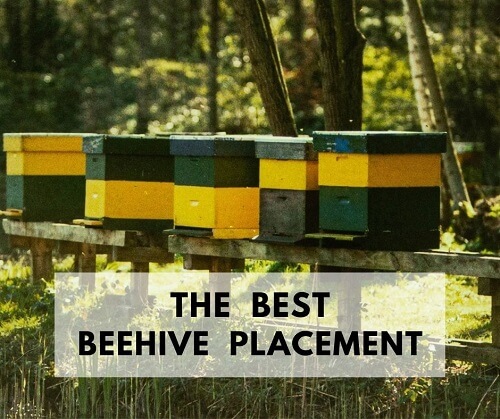

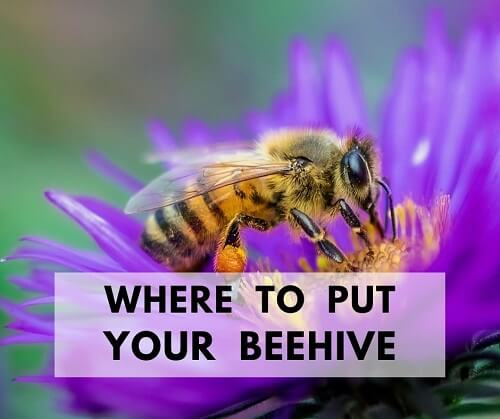


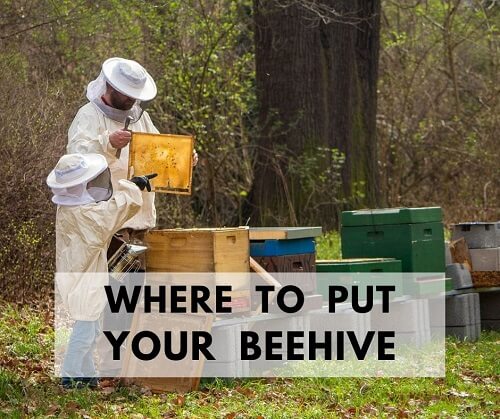




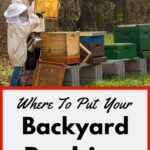



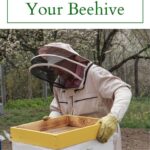
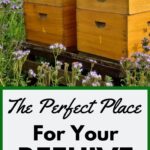
Although I am highly sensitive to bee stings, I have always wanted to raise bees. However, My first concern has been my neighbors. I have 5 acres in a semi-rural area (tiny town just 2 miles down the road, major city about 10 miles away…then mostly nothing all the way to the coast) ALL of my neighbors use highly toxic roundup and similar ‘weed’ killers frequently (even poisoning my small rain fed pond one year with toxic pink bloom from runoff of their use.) I wanted to put my hive close to my full food, flower and herb garden so they won’t want to ‘roam’ to neighbors and consume poisons that will kill them…is this possible, or will they roam anyway even if they have plenty of close by food? I know from just skimming through this post that having the hive so close to where I will be gardening is not great, but again, I’m worried for the bees. Any ideas? I do have a large pasture that is mostly open where I could locate the hive (out in the open for all to see) and, again, the bees could go to neighbors from there.
Thank you for a very informative post…I want to have everything ready before I get the hive…and I’ll also be looking at beekeeping club
Unfortunately, with the neighbors you have, there is no perfect answer. Pesticides and herbicides are one of the worst things for bees. I would keep them as far as I can from your neighbors and provide them with enough so they don’t want to roam. However, if you are highly sensitive to bee stings, (I hate to say this) you might want to forgo raising them. There is no perfect answer here. I wish I could help more.